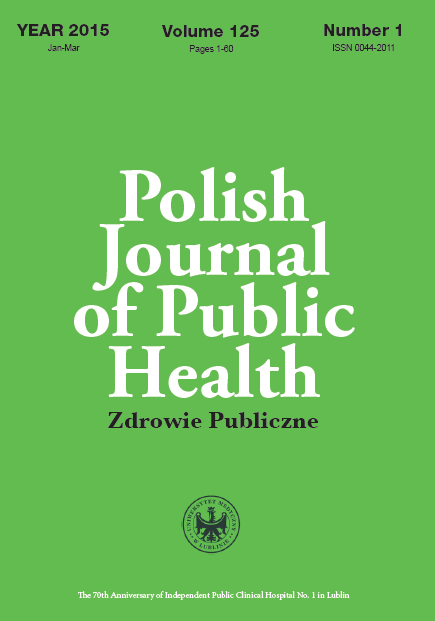What’s new about symptomatic reflux disease
DOI:
https://doi.org/10.1515/pjph-2015-0015Keywords:
gastroesophageal reflux disease, hiatal hernia, oesophagitisAbstract
During the last 4 decades reflux disease (GERD) has evolved from being a rare clinical problem to a disease with high incidence. This automatically rises its social costs. First descriptions came from western countries only but nowadays there are many published papers from Asia and Middle East that can be found on the Internet. There is no clear explanation for this fact. Our understanding of GERD has changed over the time. At first GERD, hiatal hernia and oesophagitis were synonyms. Since the 1940s when the first manometrical studies were done it was concerned as lower oesophageal sphincter or peristaltic disfunction. The following years gave a definition of acid-peptic disorder. Nowadays all this concepts are mixed together and we are considering GERD as a heterogeneous clinical problem. In this paper we would like to present up-to-date knowledge about GERD.
References
1. Numans ME, Lau J, de Wit NJ, et al. Short-term treatment with proton- pump inhibitors as a test for gastroesophageal reflux disease: a meta-analysis of diagnostic test characteristics. Ann Intern Med. 2004;140:518-27.
2. Sifrim D, Castell D, Dent J, et al. Gastro-oesophageal reflux monitoring: review and consensus report on detection and definitions of acid, nonacid, and gas reflux. Gut. 2004;53:1024-31.
3. Vakil N, van Zanten SV, Kahrilas P, et al. Global Consensus Group. The Montreal definition and classification of gastroesophageal reflux disease: a global evidence-based consensus. Am J Gastroenterol 2006;101:1900-20.
4. El-Serag HB, Sweet S, Winchester CC, et al. Update on the epidemiology of gastro-esophageal reflux disease: a systematic review. Gut. 2014;63: 871-80. [Web of Science]
5. Cook MB, Chow WH, Devesa SS. Oesophageal cancer incidence in the United States by race, sex, and histologic type, 1977-2005. Br J Cancer. 2009;101:855-9.
6. Singh S, Sharma AN, Murad MH, et al. Central adiposity is associated with increased risk of esophageal inflammation, metaplasia, and adenocarcinoma: a systematic review and meta-analysis. Clin Gastroenterol Hepatol. 2013;11:1399-412.e7
7. Kahrilas PJ, Boeckxstaens G. Failure of reflux inhibitors in clinical trials: bad drugs or wrong patients? Gut. 2012;61:1501-9.
8. de Jong JR, Besselink MG, van Ramshorst B, et al. Effects of adjustable gastric banding on gastroesophageal reflux and esophageal motility: a systematic review. Obes Rev. 2010;11:297-305. [Web of Science]
9. Hirschowitz BI. A critical analysis, with appropriate controls, of gastric acid and pepsin secretion in clinical esophagitis. Gastroenterol. 1991;101:1149-58.
10. Bardhan KD, Muller-Lissner S, Bigard MA, et al. Symptomatic gastrooesophageal reflux disease: double blind controlled study of intermittent treatment with omeprazole or ranitidine. The European Study Group. BMJ. 1999;318:502-7.
11. Miner P Jr, Katz PO, Chen Y, et al. Gastric acid control with esomeprazole, lansoprazole, omeprazole, pantoprazole, and rabeprazole: a fiveway crossover study. Am J Gastroenterol 2003;98:2616-20.
12. Fackler WK, Ours TM, Vaezi MF, et al. Long-term effect of H2RA therapy on nocturnal gastric acid breakthrough. Gastroenterol. 2002;122:625-32.
13. Wallner G, Solecki M, Tarnowski W, et al. Gastroesophageal reflux disease - clinical practice guidelines. Videosurgery. 2009;4(Suppl. 1):S16- S24.
14. Masiak W, Wallner G, Wallner J, et al. Combined esophageal multichannel intraluminal impedance and pH monitoring (MII-pH) in the diagnostics and treatment of gastroesophageal reflux disease and its complications. Pol Prz Chir. 2011;83(9):488-96.
15. Wallner G, Skoczylas T, Zinkiewicz K, et al. Own experience in the treatment of gastro-esophageal junction inability. Now Lek. 2007;76 (Suppl. 1):73.
16. Schwartz MP, Wellink H, Gooszen HG, et al. Endoscopic gastroplication for the treatment of gastro-oesophageal reflux disease: a randomised, sham-controlled trial. Gut. 2007;56:20-8. [Web of Science]
17. Arts J, Bisschops R, Blondeau K, et al. A double-blind sham-controlled study of the effect of radiofrequency energy on symptoms and distensibility of the gastro-esophageal junction in GERD. Am J Gastroenterol. 2012;107:222-30. [Web of Science]
18. Cadière GB, Van Sante N, Graves JE, et al. Two-year results of a feasibility study on antireflux transoral incisionless fundoplication using EsophyX. Surg Endosc. 2009;23:957-64. [Web of Science]
19. Ganz RA, Peters JH, Horgan S, et al. Esophageal sphincter device for gastroesophageal reflux disease. N Engl J Med. 2013;368:719-27.
20. Rodríguez L, Rodriguez P, Gómez B, et al. Long-term results of electrical stimulation of the lower esophageal sphincter for the treatment of gastroesophageal reflux disease. Endoscopy. 2013;45(8):595-604. [Web of Science]
Downloads
Published
Issue
Section
License
Copyright (c) 2015 Polish Journal of Public Health

This work is licensed under a Creative Commons Attribution-NonCommercial-NoDerivatives 3.0 Unported License.


